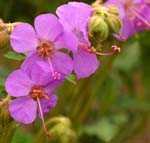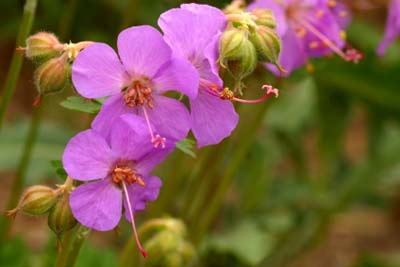Invest in geraniums for your garden
Now is the perfect time to place an order for geraniums, or pelargoniums


** If you want to buy any of the plants mentioned below for your own garden, visit www.countrylife.co.uk/nursery
and type or copy and paste the name into the search. Plants are
delivered in sturdy boxes in a matter of days from one of the finest
nurseries in the country. **
In 1820, those careful botanists whose job it is to review the nomenclature of particular groups of plants-a practice known as ‘splitting' or ‘clumping', dep-ending on whether the relevant genus is subdivided or enlarged -decided that the genus Geranium was really made up of two quite separate parts.
The hardy cranesbills were retained in the genus Geranium, but the half-hardy and tender creatures were hived off into a new genus called Pelargonium. All this sounds straightforward, except that the gardening public took no notice whatsoever; it remains the case that, unless we're on our very best behaviour, we call geraniums cranesbills and pelargoniums ‘geraniums'.
The genus Pelargonium contains some of the most popular and desirable plants of the 19th century; of South African origin, the species were found to be easy to grow in pots and most amenable to propagation by cuttings. And gardeners brandishing soft paintbrushes soon discovered that the various species could be readily hybridised, leading to all sorts of exciting combinations of form, foliage and flower colour. A prize-winning genus emerged, even if no one could quite commit themselves to its given name.
Sign up for the Country Life Newsletter
Exquisite houses, the beauty of Nature, and how to get the most from your life, straight to your inbox.
Now is the perfect time to place your order with one of the specialist suppliers (see below), with plants being generally despatched in May and June. The traditional time for taking cuttings is late August, when they can easily be persuaded to root in a free-draining compost with a bit of bottom heat. The cuttings then have to be overwintered under glass, but the thrifty gardener knows that the young plants will be sufficiently advanced by springtime for a second batch of cuttings to be taken from them, and that they'll rapidly catch up.

* Subscribe to Country Life and save; Get the Ipad edition
As soon as they're rooted, they can go into 3in pots, then up to 5in pots, before being bedded out at the end of May, or taking up residence on a windowsill. I distantly remember doing all this with hundreds of the old scarlet bedder Paul Crampel,a survivor of the ribbon bedding of 19th-century gardens (often planted parallel with yellow Calceolaria and, in front, blue Lobelia). I spotted a lonely plant of Paul Crampel glowing in a cold frame in Sussex last year, waiting for the golden age to return.
Many other Victorian cultivars have gone similarly under a cloud in modern times, but there remain sufficient enthusiasts and specialist nurseries to keep these beauties going until the great day dawns when they become fashionable once again. They include all those sensational coloured- leaved kinds, the cynosure of which is the venerable Mr Henry Cox, with startlingly splashed leaves in combinations of green, yellow and red. These bizarrely wonderful colour forms are many and various: the serious collector can spend hours comparing the merits of Lass o' Gowrie, Mrs Pollock and Sophie Dumaresque.
Among the most elegant of the 19th-century forms of Pelargonium are the Uniques. They're rather tall, and should be allowed their rangy form in the summer, before being cut down by half each spring. Among the loveliest cultivars is Purple Unique, whose thinly spread, but large and elegant blooms decorate the handsome plant with an easy grace. The Uniques have some of that added refinement shared by so many in this genus: delicately scented foliage.
Really, these old-fashioned geraniums are happiest in cool greenhouses, but they make excellent bedding and hanging-basket plants for the summer, and many, including the outstanding Royal Oak, grow increasingly magnificent if they're kept fed and watered in clay pots, reaching noble proportions by September. For those of us who remember geraniums as the staple of the cottage windowsill, the long wait for this richly varied genus to return to centre stage cannot be put off much longer.
Specialist suppliers of heritage pelargoniums include Fibrex Nurseries (01789 720788; www. fibrex.co.uk); The Vernon Geranium Nursery (0844 573 6010; www.geraniumsuk.com); Woot- tens of Wenhaston (01502 478258; www.woottensplants.com)
You can order plants in bold from www.countrylife.co.uk/nursery
*Follow Country Life magazine on Twitter
Country Life is unlike any other magazine: the only glossy weekly on the newsstand and the only magazine that has been guest-edited by HRH The King not once, but twice. It is a celebration of modern rural life and all its diverse joys and pleasures — that was first published in Queen Victoria's Diamond Jubilee year. Our eclectic mixture of witty and informative content — from the most up-to-date property news and commentary and a coveted glimpse inside some of the UK's best houses and gardens, to gardening, the arts and interior design, written by experts in their field — still cannot be found in print or online, anywhere else.
-
 380 acres and 90 bedrooms on the £25m private island being sold by one of Britain's top music producers
380 acres and 90 bedrooms on the £25m private island being sold by one of Britain's top music producersStormzy, Rihanna and the Rolling Stones are just a part of the story at Osea Island, a dot on the map in the seas off Essex.
By Lotte Brundle
-
 'A delicious chance to step back in time and bask in the best of Britain': An insider's guide to The Season
'A delicious chance to step back in time and bask in the best of Britain': An insider's guide to The SeasonHere's how to navigate this summer's top events in style, from those who know best.
By Madeleine Silver